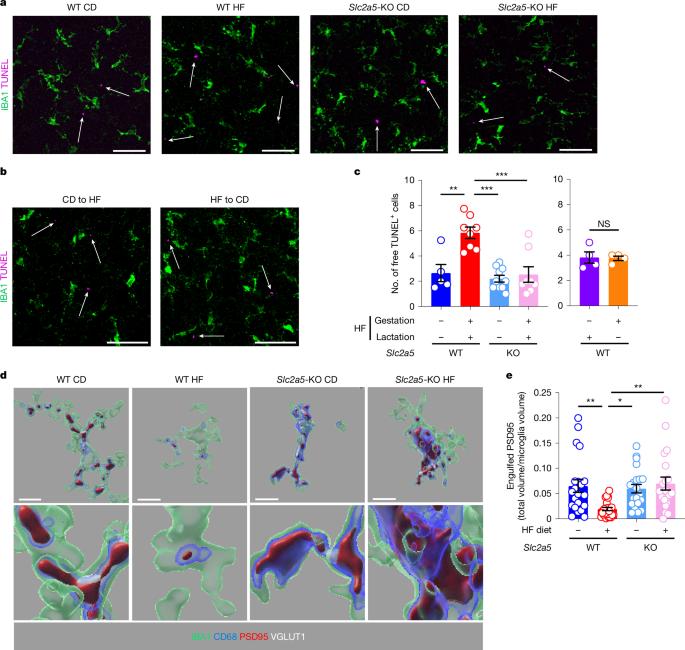Early life high fructose impairs microglial phagocytosis and neurodevelopment
IF 48.5
1区 综合性期刊
Q1 MULTIDISCIPLINARY SCIENCES
引用次数: 0
Abstract
Despite the success of fructose as a low-cost food additive, epidemiological evidence suggests that high fructose consumption during pregnancy or adolescence is associated with disrupted neurodevelopment1–3. An essential step in appropriate mammalian neurodevelopment is the phagocytic elimination of newly formed neurons by microglia, the resident professional phagocyte of the central nervous system4. Whether high fructose consumption in early life affects microglial phagocytosis and whether this directly affects neurodevelopment remains unknown. Here we show that offspring born to female mice fed a high-fructose diet and neonates exposed to high fructose exhibit decreased phagocytic activity in vivo. Notably, deletion of the high-affinity fructose transporter GLUT5 (also known as SLC2A5) in neonatal microglia completely reversed microglia phagocytic dysfunction, suggesting that high fructose directly affects neonatal development by suppressing microglial phagocytosis. Mechanistically, we found that high-fructose treatment of mouse and human microglia suppresses phagocytosis capacity, which is rescued in GLUT5-deficient microglia. Additionally, we found that high fructose drives significant GLUT5-dependent fructose uptake and catabolism to fructose 6-phosphate, rewiring microglial metabolism towards a hypo-phagocytic state in part by enforcing mitochondrial localization of the enzyme hexokinase 2. Mice exposed to high fructose as neonates develop anxiety-like behaviour as adolescents—an effect that is rescued in GLUT5-deficient mice. Our findings provide a mechanistic explanation for the epidemiological observation that high-fructose exposure during early life is associated with increased prevalence of adolescent anxiety disorders. Exposure of mice to high fructose during gestation or early postnatal life causes decreased microglial phagocytosis during brain development and leads to anxiety-like behaviour in adolescence.


生命早期高果糖损害小胶质细胞吞噬和神经发育
尽管果糖作为一种低成本的食品添加剂获得了成功,但流行病学证据表明,怀孕或青春期摄入大量果糖与神经发育紊乱有关。哺乳动物神经发育的一个重要步骤是小胶质细胞吞噬掉新形成的神经元,小胶质细胞是中枢神经系统的常驻专业吞噬细胞。生命早期高果糖摄入是否会影响小胶质细胞吞噬以及这是否会直接影响神经发育仍然未知。在这里,我们发现喂食高果糖饮食的雌性小鼠所生的后代和暴露于高果糖饮食的新生儿在体内表现出降低的吞噬活性。值得注意的是,新生儿小胶质细胞中高亲和力果糖转运体GLUT5(也称为SLC2A5)的缺失完全逆转了小胶质细胞的吞噬功能障碍,这表明高果糖通过抑制小胶质细胞的吞噬作用直接影响新生儿的发育。在机制上,我们发现小鼠和人类小胶质细胞的高果糖处理抑制了吞噬能力,这在缺乏glut5的小胶质细胞中得到了恢复。此外,我们发现高果糖驱动显著的glut5依赖性果糖摄取和分解代谢为果糖6-磷酸,部分通过加强线粒体己糖激酶2的定位,将小胶质细胞代谢重新连接到低吞噬状态。刚出生时接触高果糖的老鼠在青春期会表现出类似焦虑的行为——这种效应在缺乏glut5的老鼠身上得到了拯救。我们的研究结果为流行病学观察提供了一种机制解释,即早期生活中的高果糖暴露与青少年焦虑症的患病率增加有关。
本文章由计算机程序翻译,如有差异,请以英文原文为准。
求助全文
约1分钟内获得全文
求助全文
来源期刊

Nature
综合性期刊-综合性期刊
CiteScore
90.00
自引率
1.20%
发文量
3652
审稿时长
3 months
期刊介绍:
Nature is a prestigious international journal that publishes peer-reviewed research in various scientific and technological fields. The selection of articles is based on criteria such as originality, importance, interdisciplinary relevance, timeliness, accessibility, elegance, and surprising conclusions. In addition to showcasing significant scientific advances, Nature delivers rapid, authoritative, insightful news, and interpretation of current and upcoming trends impacting science, scientists, and the broader public. The journal serves a dual purpose: firstly, to promptly share noteworthy scientific advances and foster discussions among scientists, and secondly, to ensure the swift dissemination of scientific results globally, emphasizing their significance for knowledge, culture, and daily life.
 求助内容:
求助内容: 应助结果提醒方式:
应助结果提醒方式:


